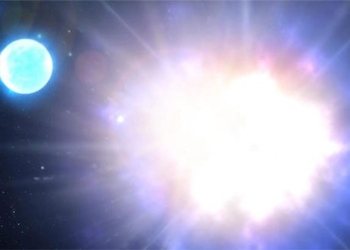Two super telescopes have confirmed that the ancient galaxy ceers-2112 is indeed a perfect replica of the Milky Way, the “monster” galaxy that Earth inhabits. This revelation is utterly astonishing.
According to Science Alert, numerous factors influence the shape of a galaxy, ranging from collisions and mergers to the density of neighboring galaxies.
For instance, our Milky Way, the “monster” galaxy, has achieved its colossal size and shape through a lengthy evolutionary process, involving around 20 collisions where it absorbed other galaxies.
Thus, widely accepted astronomical theories suggest that “monsters” like the Milky Way – a barred spiral galaxy – did not exist until about 8 billion years ago.
The emergence of ceers-2112 turns everything upside down.

Graphic depicting an ancient galaxy with a red hue from the redshift phenomenon caused by the expansion of the universe – (Image: SPACE.COM).
In a publication in the journal Nature, an international team of scientists led by astronomer Luca Costantin from the Center for Astrobiology (CAB, INTA-CSIC) in Madrid, Spain, reported that ceers-2112 emerged just 2 billion years after the Big Bang.
This means we are observing its image from 12 billion years ago, at an age that is quite mature.
After billions of years of travel, its “tunneling” light has reached the James Webb Space Telescope. Using additional data from the Hubble Space Telescope, the nature of this ancient system has been revealed.
It is an incredibly complex spiral structure, with a bar similar to that of the Milky Way, perhaps just slightly smaller.
Although this galaxy is too distant and faint to observe its spiral arms in detail, the detection of a thick central bar is enough to convince astronomers that ceers-2112 has developed to be large and complex for its age.
The bar of the galaxy consists of a collection of stars clustered in the central region, creating a structure that resembles a bar.
According to co-author Alexander de la Vega from the University of California, Riverside, this indicates that ceers-2112 matured and organized faster than previously thought about galaxy formation and evolution.
This implies that some fundamental theories will need to be rewritten.
Previously, it was believed that bar structures could not form or exist for long in the early universe, where nascent galaxies were highly chaotic and unstable.
This magnificent spiral could also be the result of many “monstrous” behaviors, similar to what the Milky Way has done in its history, such as engulfing other galaxies to grow.
However, with an age of no more than 2 billion years at the time of observation, it seems almost impossible for it to have had enough time to accomplish even a fraction of what we believe helped the Milky Way become great as it is today.
This discovery, combined with a series of stunning findings about the early universe, includes galaxies that are too bright or supermassive black holes that are developing too quickly.
Scientists hope that the upcoming data collected by James Webb will help them uncover more “incredible” objects like ceers-2112, aiding in solving the mysteries of the few billion years following the Big Bang.





















































